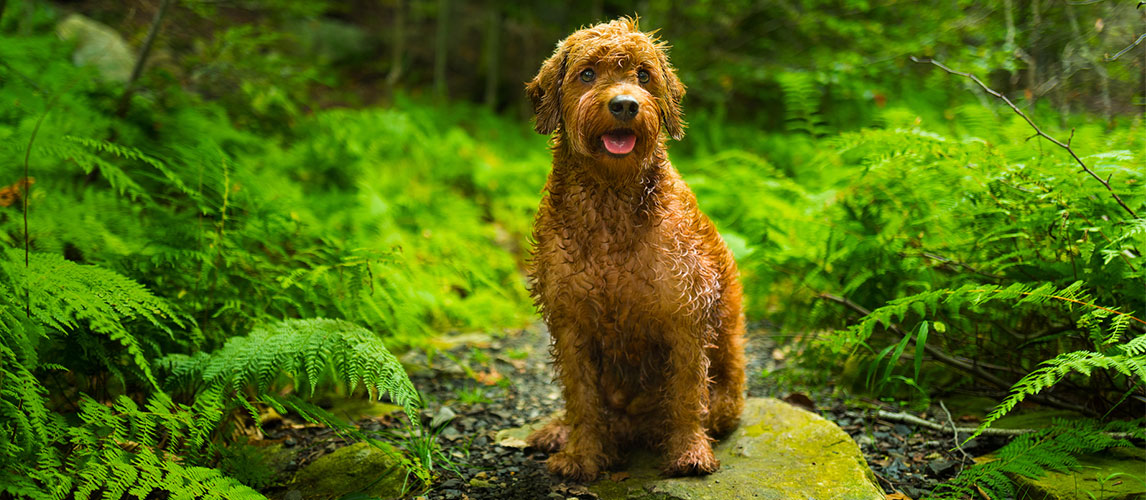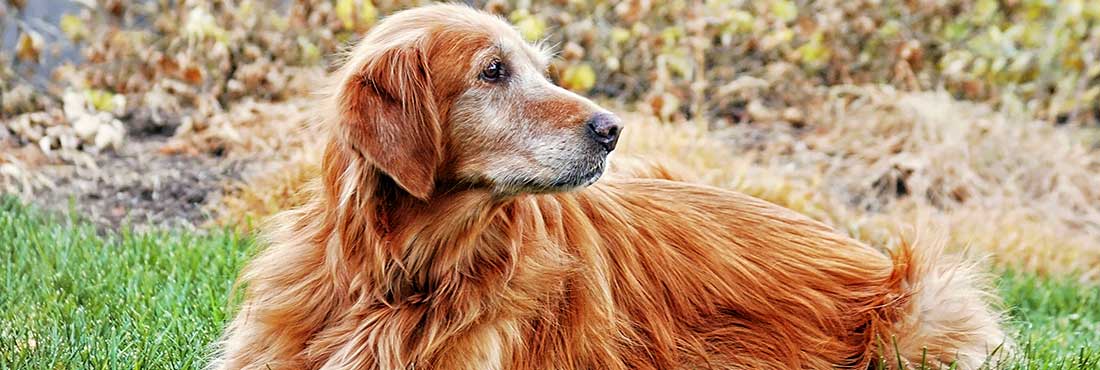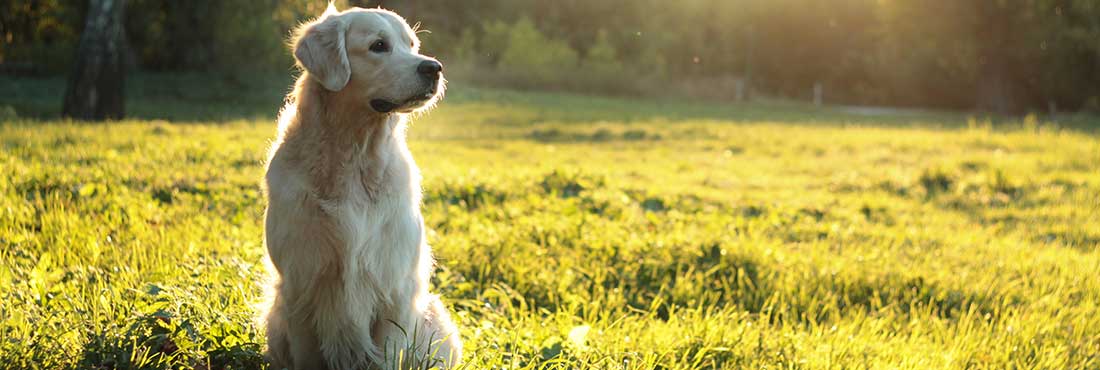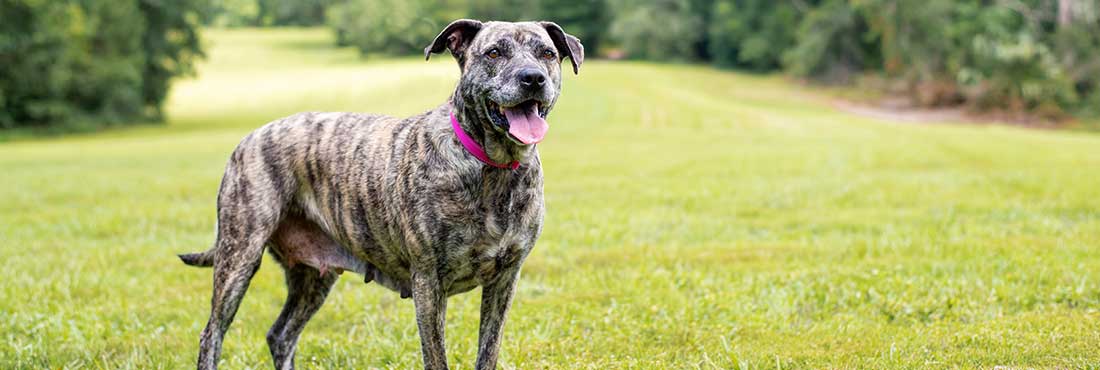One of the most popular designer dog breeds, the Goldendoodle is affectionate and intelligent. And, as it is a hybrid between the parent breeds of poodle and the golden retriever, it is also low shedding, so a good choice if you or someone in your family suffers from allergies.
While not a full pure breed, there is much to love about the family-friendly Goldendoodle. We take an in-depth look into this gorgeous medium-sized breed so you can decide whether it’s the dog for you.
Short History of the Goldendoodle
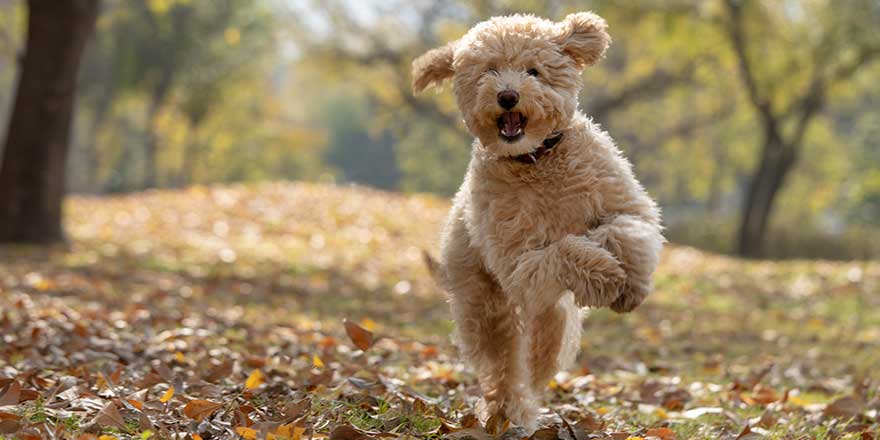
The Goldendoodle is one of the newest ‘Doodle’ mixes as a hybrid or crossbreed. The Goldendoodle was originally bred in the 1960s to be used as a guide dog. But it was in the 1990s that the Goldendoodle started to come to prominence as a family pet following the earlier success of the other Doodle mixes, the Cockapoo and the Labradoodle. As a relatively new crossbreed, many of today’s Goldendoodle puppies are still the result of first-generation breeding between purebred poodles and golden retrievers. Breeding between Goldendoodles is still rare.
Affectionate and gentle, the Goldendoodle was also developed to create a larger dog than the Doodle, which was also low shedding. With the poodle’s propensity for low dander in their fur, the thinking is that the Goldendoodle, like the Doodle, is a good pet choice if there are pet allergy sufferers in the home. Over the past decade, the Goldendoodle has soared in popularity, especially in Australia. However, the Goldendoodle and other designer cross-breed remain unrecognized by the American Kennel Club. The breed is recognized by the Designer Dogs Kennel Club, which was established in 2007.
Who are the parents?
The Goldendoodle is the result of a poodle bred with a golden retriever. The Goldendoodle puppy can take on some or all their parent breeds’ characteristics, with some dominating more than others. Here’s the lowdown on the key characteristics of each parent.
Golden Retriever
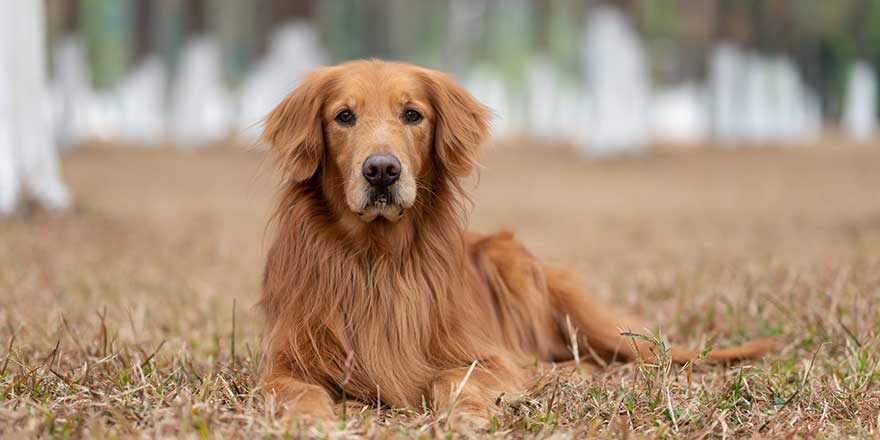
Consistently one of the most popular breeds in the United States, the loyal golden retriever makes a wonderful family pet. They have a friendly, tolerant, and affectionate nature, plus a smart brain, which makes them both trainable and a natural companion. They also excel at dog sports and, as higher energy dog, needs plenty of exercise and stimulation.
As medium to large-sized dogs, they can be boisterous, but their energy and attitude are well-meaning. They have a medium-length coat that sheds all year round and requires daily grooming. Healthwise, they are prone to a few conditions, including hip/elbow dysplasia, progressive retinal atrophy, cataracts, epilepsy, and allergies. The average life span of a golden retriever is 10-12 years.
Poodle
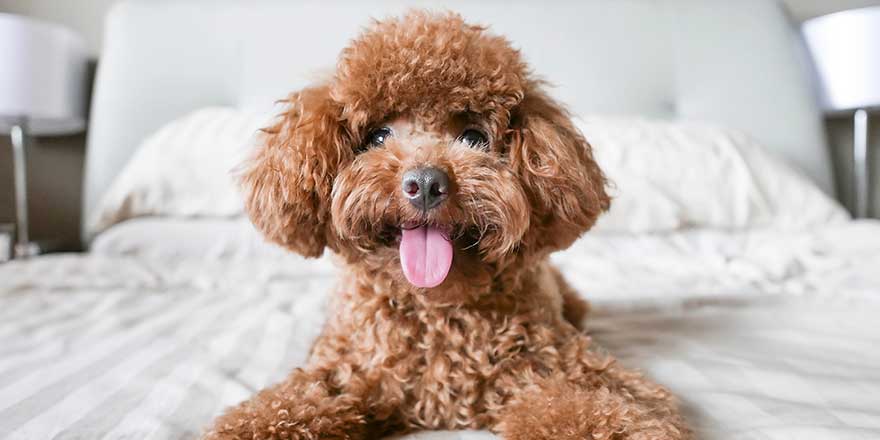
Highly trainable, the poodle is also considered one of the most intelligent dog breeds. The poodle comes in three sizes – toy, miniature, and standard. The standard poodle is the oldest type and was originally bred as a water retriever.
Personality-wise, the poodle is switched on and playful, although they can display an aloof, almost regal air. However, the poodle is very much a people-person and is happiest when part of a human pack. This means they can be prone to separation anxiety, resulting in destructive behavior if left alone for too long.
While there is no such thing as a truly hypoallergenic dog, the poodle coat is low shedding and dander, which means it is one of the best breeds to consider if you suffer from allergies. However, that curly, dense poodle coat requires great care and attention. The poodle can be more susceptible to certain health issues, including Addison’s disease, bloat, Cushing’s disease, hip dysplasia, and epilepsy.
Essential Breed Facts about the Goldendoodle
Before we dig deeper into the practicalities of owning a Goldendoodle, here are some of the essential facts about this hybrid breed:
- For its size, the Goldendoodle has a decent life span. This designer breed can live for an average of between 10 and 15 years.
- The Goldendoodle is a versatile working dog. From acting as guide, service, and therapy dogs, the breed is also renowned for its ability at agility and canine sports.
- If you are looking for a guard dog, the Goldendoodle is not for you! They are not known to be vocal and are unlikely to bark or alert you to an issue. They are also more prone to lick than warn away any strangers.
- As an inherently sociable dog, the Goldendoodle is prone to separation anxiety if left alone for too long. And they are not natural outdoor pets, so should have their own happy space inside your home.
- That Goldendoodle fur may look extra luxurious, but it is also low shedding and collects minimal dander. And this could all add up to good news if you want to have a dog but suffer from mild allergies. However, it’s important to note that there is no such thing as a hypoallergenic dog, and the Goldendoodle will still shed his coat.
- Combining the friendly, affectionate, and loyal personality traits of their parent breeds, the Goldendoodle makes an excellent pet for active families and generally gets along with dogs, pets, and other animals.
Key Characteristics
Energetic, smart, and loving, the Goldendoodle distills the traits of its parent breeds into one super-fluffy pooch. Here are the key characteristics of this awesome crossbreed:
Appearance
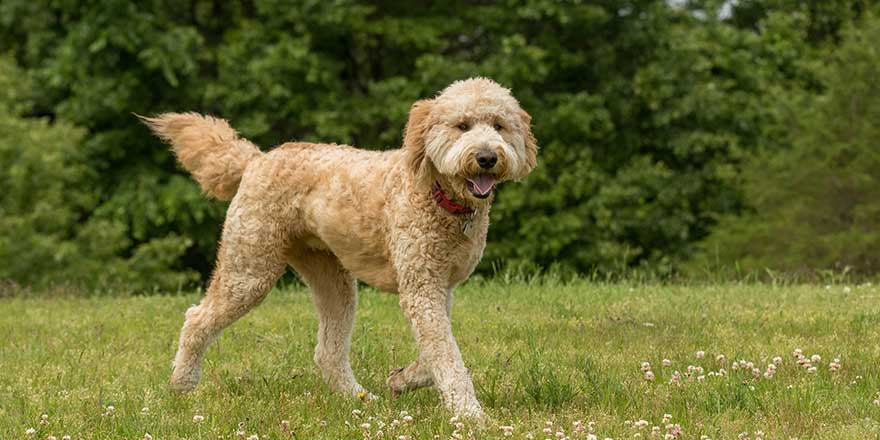
The Goldendoodle should have the sturdy body of the retriever and the long limbs of both parent breeds. They can be small to medium/large in height and have friendly, open faces and warm, kind eyes. The Goldendoodle can have one of three coat types or a combination of straight, wavy, and curly, which should be typically between two and three inches in length. The longer hair will be on its tail, body, and ears, with some slight feathering on their legs. The hair on their head and muzzle will be dense too but tends to be shorter.
Color-wise, as the Goldendoodle is not an official breed, there is no breed standard set by the American Kennel Club, including accepted coat color. But in general, Goldendoodles are available in a range of colors, including copper, white, cream, and golden, which is the most common. You can also get Goldendoodles in black, apricot, and red. Whatever color your Goldendoodle is, their coat color will tend to lighten with age.
Size
As there are three sizes of poodles (toy, miniature, and standard), the Goldendoodle will vary in size due to the size of the parent poodle used in the breeding. While there is currently no breed standard, this means you can get a toy, miniature, or standard Goldendoodle.
A miniature Goldendoodle size (with a miniature or toy poodle as one of the parents) will range from 13 – 20 includes in height and weigh up to 25 pounds. A standard Goldendoodle size can range from 17 to 24 inches and weigh between 40 and 90 pounds.
How to Tell What a Goldendoodle Will Look Like
As Goldendoodles are hybrids – not a true pure breed – it can be difficult to anticipate what a Goldendoodle puppy will look like. And this is because breeders don’t know exactly what characteristics from each parent breed will come through.
Seeing both of the puppy’s parents can help you to anticipate how your Goldendoodle puppy will look as they grow up. But you should expect variants as the Goldendoodle coat can come in a wide range of colors and in one of three coat types. But for many, that is the beauty of a designer or hybrid dog breed and the potential for genetic diversity – each one will have its differences and shared characteristics.
Temperament

With two such people-focused parent breeds, the Goldendoodle is a social butterfly! They tend to get along with everyone and love their human pack and can be both high energy and gentle, depending on the circumstances. They enjoy company also snuggle time, and the breed’s positivity is endearing as all he wants to do is make friends!
The smart brain of the Goldendoodle means he is great fun to exercise and play with, although he can be mischievous if he thinks he can get away with it. Although a big dog, the Goldendoodle is patient enough to thrive with small children, other dogs, and family pets.
His sociable nature, however, means the Goldendoodle can suffer from separation anxiety, so it’s important that they live inside the family home and are not left for long periods. They are not suited to apartment living unless you have some secure outdoor space or a fenced yard.
Everything you Need to Know about Caring for a Goldendoodle
If you want to welcome a new dog into your home, the Goldendoodle could be the golden choice, thanks to their personality and easy approach to life. However, with that fluffy coat and high energy levels, they do need some thoughtful care. Here are all the practical essentials you need to know about owning a gorgeous Goldendoodle.
Training
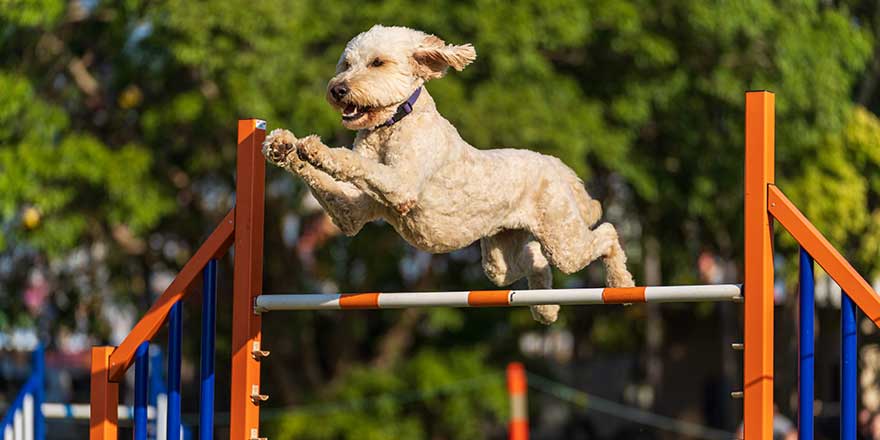
As both golden retrievers and poodles are known for their intelligence, the Goldendoodle also has a smart brain. The Goldendoodle is also not particularly known for aggressive behavior. And this means they can be easy to train, making them a good choice for first-time dog owners.
Proper socialization from an early age is a must for the Goldendoodle, as it means you can raise a confident, kind, and socially adept puppy that is comfortable with other dogs, pets, people, and different situations. Enrolling your young Goldendoodle in a puppy kindergarten class will get him socializing nicely. Crate training your Goldendoodle puppy is also a good idea as it can help you to deal with separation anxiety and any associated destructive behaviors.
As he is eager to please, dog obedience and training classes should be a pleasure for you both and will help to provide mental stimulation for that switched-on brain. But only positive reinforcement training methods should be used, as the Goldendoodle can react negatively to any harsher training.
Exercise
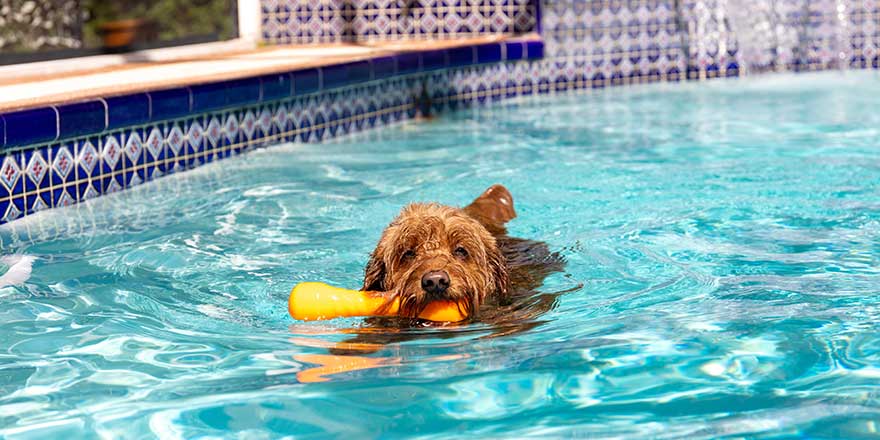
The Goldendoodle needs at least 20-30 minutes of exercise daily as an average energy level dog. This can comprise walking, hiking, playing in the park, and even swimming, as Goldendoodles are known to be water lovers. And if you are at work during the week, consider employing dog walkers, so your pooch has consistent exercise daily.
To prevent boredom, it’s a good idea to through in a mix of playtime games during the day, or enroll your Golden in an agility or obedience class and watch him excel. Goldendoodles also need access to an enclosed garden or yard so they can spend some quality time outside each day.
Grooming
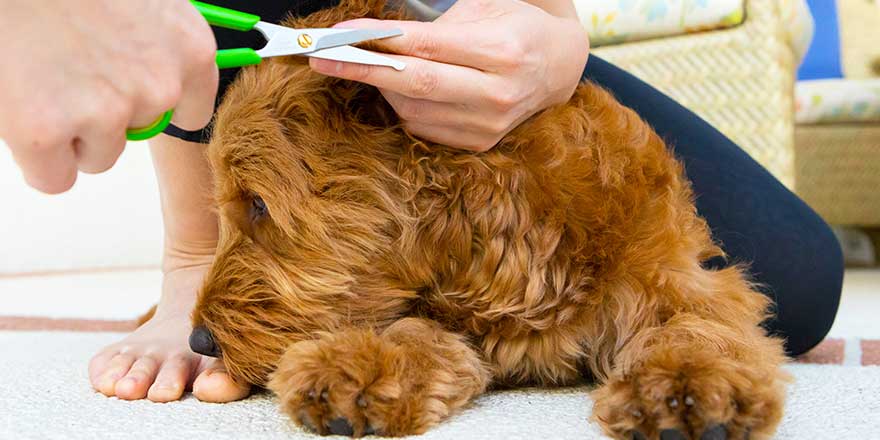
While that lovely soft coat is a very light shedder, the Goldendoodle does require a regular grooming routine to keep their coat in tip-top condition. You must brush them at least twice a week and should also consider having them regularly clipped by a professional dog groomer. The good news is that the Goldendoodle only needs bathing when needed as their coat needs to retain all those natural oils for moisture.
Aside from their coat, you must include their teeth, ears, eyes, and nails into your Goldendoodle’s regular grooming routine. Brush their teeth at least twice weekly to prevent bleeding gums and whiffy dog breath. And their ears and eyes should be regularly checked and, if necessary, gently cleaned to prevent inflammation and any ear infections. And finally, trim their nails as needed, ideally at least once a month, if they are not getting worn down naturally during their daily walk and exercise.
Feeding
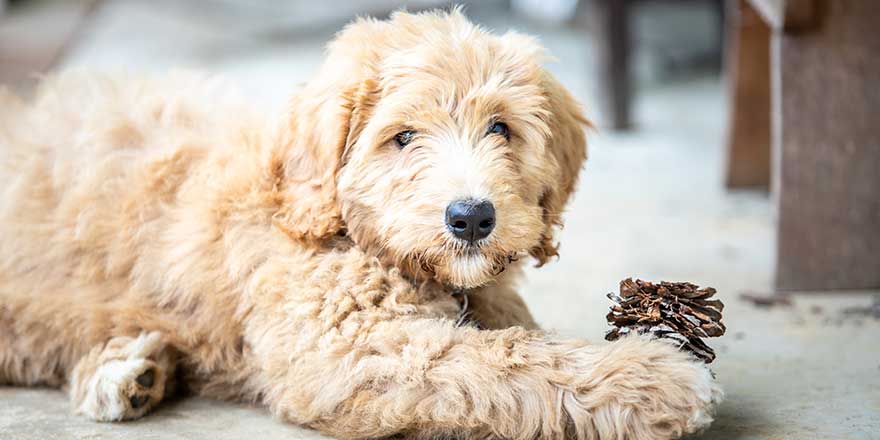
As the golden retriever parent breed is prone to digestive issues and bloat, you should aim to feed your Goldendoodle several small meals per day rather than one large one. Always opt for high-quality dog food with whole protein formulated for your pet’s specific life stage. Depending on the age and size of your Goldendoodle, you should be feeding them one to four cups of dog food, divided into at least two meals per day, morning and evening. For a new puppy, you will need to feed them little and often at the start.
Any treats for your Goldendoodle should be kept to a minimum and make up no more than 10% of your pet’s daily food intake. Always seek professional advice if you are unsure how much you should be feeding your Goldendoodle.
Health
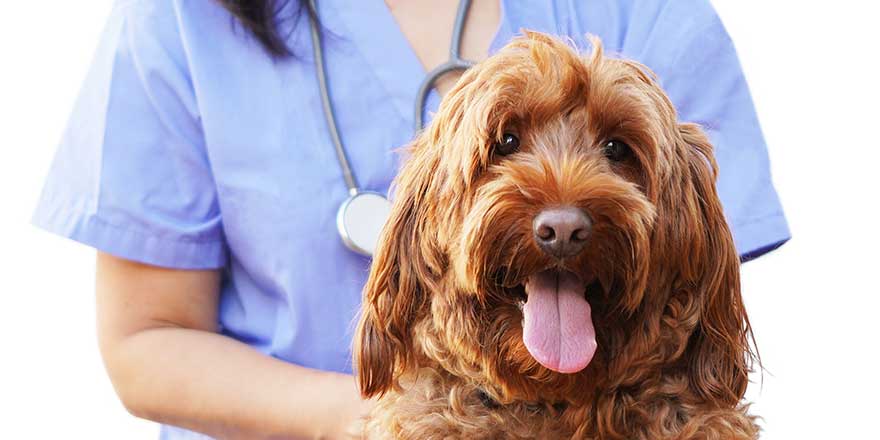
As a mixed breed, the Goldendoodle is known to be generally healthy but, like all dog breeds, can be prone to certain health conditions. This can also include health issues specific to the parent breeds of golden retrievers and poodles. When buying a new puppy, always use a reputable breeder and ask to see health clearances for both parent dogs. These should include clearances from the Canine Eye Registry Foundation and the Orthopedic Foundation for Animals.
The following are the main conditions that could affect even well-bred Goldendoodles include:
- Patellar luxation – this is a condition where the patella (or kneecap) slips out of position, causing pain. While this dislocation can cause pain and lameness, most dogs can lead relatively normal lives with treatment.
- Von Willebrand’s Disease – a blood disorder that affects clotting. This condition can lead to symptoms such as nose bleeds, bleeding gums, and prolonged bleeding after surgery. It cannot be cured but can be managed throughout a dog’s life.
- Hip dysplasia/elbow dysplasia – both are inherited conditions where the hip or elbow doesn’t fit correctly into the joint, causing lameness, pain, and eventually arthritis. Treatments include medication, weight loss, and surgery.
- Gastric Dilatation-Volvulus – also known as bloat- is a condition that affects large, deep-chested dogs and can be life-threatening. It occurs when the stomach gets distended with gas and twists, meaning the dog cannot belch or vomit to eliminate the excess air. Untreated, it can prove fatal. To help prevent bloat in your Goldendoodle, avoid feeding just one large meal a day, and don’t let them eat rapidly or gulp large amounts of water after feeding.
- Progressive Retinal Atrophy – affecting the eye, this condition gradually causes deterioration in the retina. As the disease progresses, a dog can suffer from night blindness and eventually loss of vision.
- Hypothyroidism – affecting the thyroid gland, symptoms of hypothyroidism include hair loss, weight gain, lethargy, and issues with the skin. Hypothyroidism can be managed via diet and medication.
- Allergies – the Goldendoodle breed is particularly prone to allergies, including food and skin.
Welcoming a Goldendoodle Into Your Home
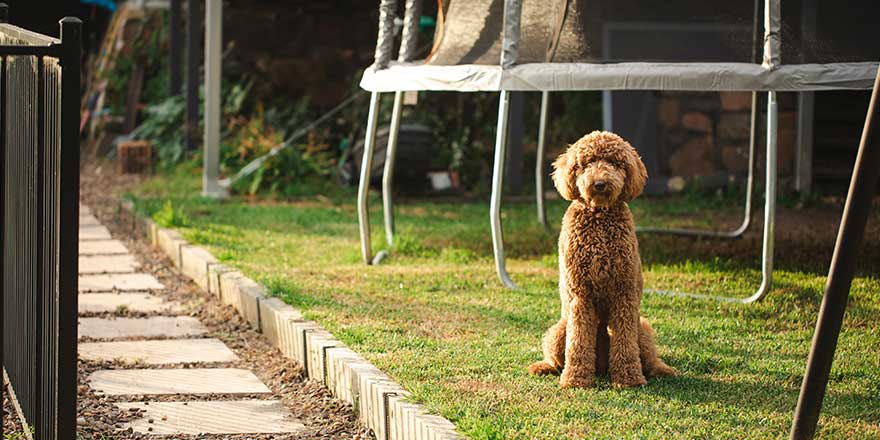
When buying a new Goldendoodle puppy, always buy from a reputable breeder and never from a puppy mill or pet store. Ask to see the puppy’s parents and grandparents, if you can, and ask your Goldendoodle breeders for evidence of health checks and clearances. And, by seeing relatives of your new puppy, you can get an idea of their temperament as they grow up. Alternatively, you could adopt not shop. While Goldendoodles are popular, some do find themselves in rescue centers. For more information, check out rehoming organizations such as Poo-Mix Rescue.
Frequently Asked Questions
A mini Goldendoodle is a mix between a golden retriever and a toy or miniature poodle. This means that they will not be very small dogs and can be a small to medium size. As a guide, miniature Goldendoodles can grow to 13 to 20 inches in height as an adult dog and weigh up to 35 pounds.
Yes, Goldendoodles can make wonderful pets for young children. They have the energy to keep up with kids, are intelligent, fun and love to play. They are also loyal and love to be part of a human pack. But it is essential that your Goldendoodle pup is socialized early so it can happily cope with young children.
And don’t forget, your child or children will need training too, in how to behave with a dog. And finally, never leave any young children unsupervised with any pet. Stick to these rules and your children and Goldendoodle will be lifelong best friends.
As with any dog breed, several factors can impact on the rate of your Goldendoodle’ puppy’s growth, including diet, environment, and genetics. But a healthy standard Goldendoodle can expect to reach its full adult weight and maturity at around 16 months, although for some dogs it can take up to two years.
The smaller Miniature Goldendoodle, however, will develop and grow at a faster rate than its larger counterpart. With a mini, you can expect them to reach their full adult weight and maturity by one year of age, give or take a few months. If you have any concerns about your Goldendoodle puppy’s development, always see your veterinarian for professional advice.
Although they are technically a mixed breed, you should expect to pay a premium price for a Goldendoodle. And this is because they are such a popular and in-demand breed. Prices for Goldendoodles vary quite widely so always ensure you are buying from a reputable breeder.
Price wise, the average price you should expect to pay for a Goldendoodle puppy is between $2,000 and $5,000, depending on the breeding and parents. For show-quality, fully trained Goldendoodles you could pay up to $12,000.
And let’s not forget that you need to factor in the cost of looking after your new pup, including all his necessary equipment, toys, food, inoculations, training costs, and essential veterinary care. But if your heart is set on one of these gorgeous golden dogs, and have the funds then you can’t put a price on what could be your perfect canine friend of a lifetime.


